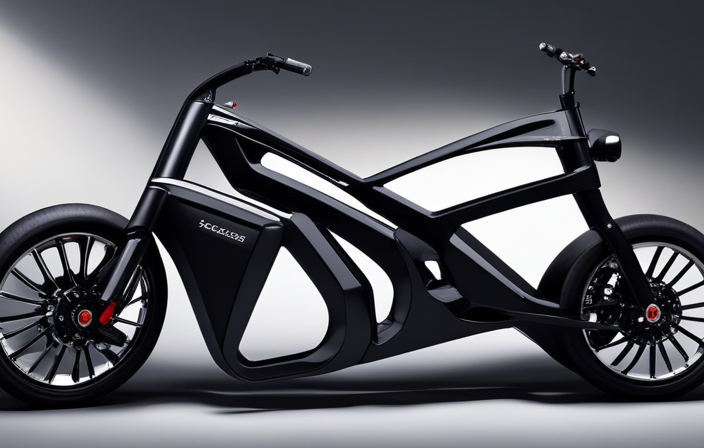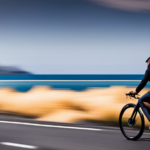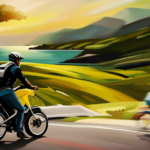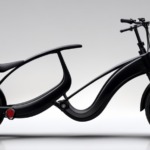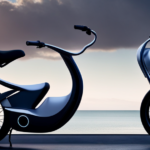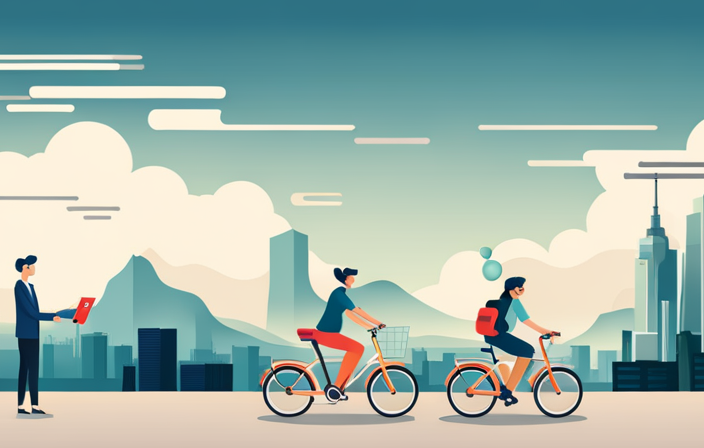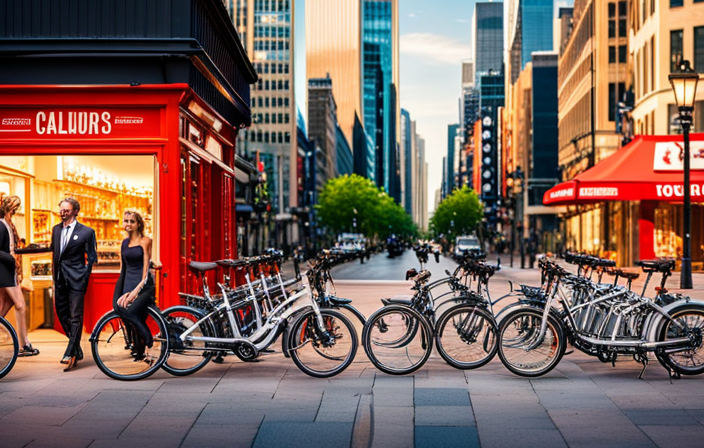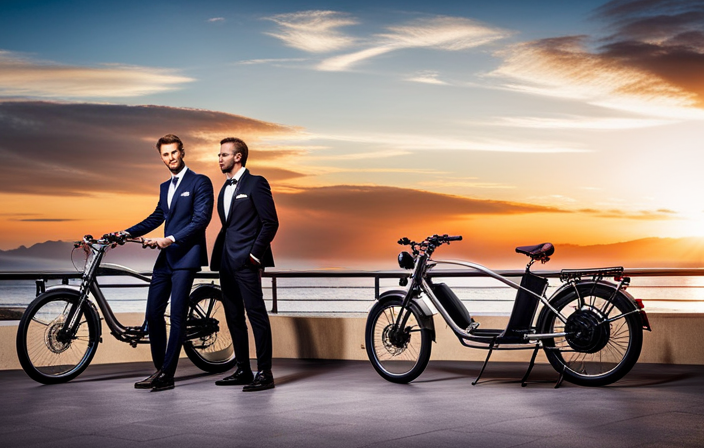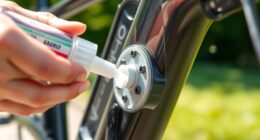As an avid cyclist, I’ve always appreciated the thrill of speed and the freedom it brings. But when it comes to electric bikes, the question of how fast they can go has always intrigued me.
So, let’s dive into the world of electric bikes and explore the factors that determine their speed. From the types of electric bikes to the power of the motor, we’ll uncover the secrets behind reaching top speeds on these two-wheeled wonders.
Get ready to pedal, because we’re about to accelerate into the world of electric bike speed.
Key Takeaways
- Electric bikes typically assist up to 20 mph (32 km/h).
- Different countries may have specific speed regulations for electric bikes.
- The speed of an electric bike can be influenced by factors such as terrain, weight, and battery power.
- There are different classifications of electric bikes with varying speed options, including pedal-assist only bikes, throttle-assisted bikes, and higher speed bikes.
Types of Electric Bikes
There are different types of electric bikes available in the market. When it comes to motor types, there are mainly two options: hub motors and mid-drive motors.
Hub motors are located in the wheel hub and provide a direct drive, making them simple and low-maintenance.
On the other hand, mid-drive motors are located near the pedals, which provides better weight distribution and more efficient power transfer.
As for speed regulations, electric bikes are typically designed to assist the rider up to a certain speed limit, usually around 20 mph (32 km/h). However, it’s important to note that different countries and regions may have specific regulations regarding maximum speed for electric bikes.
Now, let’s delve into the next section about motor power and performance.
Motor Power and Performance
The motor’s power and performance greatly impact the speed at which an e-bike can travel. The motor torque, or rotational force, determines how efficiently the motor can propel the bike forward. Higher torque means better acceleration and climbing ability.
Additionally, the speed controller plays a crucial role in determining the top speed of an e-bike. It regulates the amount of power delivered to the motor, controlling how fast the bike can go. By adjusting the settings on the speed controller, riders can customize the top speed to their preference or to comply with local regulations.
Understanding the motor power and performance, as well as the speed controller, is essential in choosing the right e-bike for your needs.
Transitioning into the next section, let’s explore the differences between pedal-assist and throttle-controlled e-bikes.
Pedal-Assist vs. Throttle-Controlled
When it comes to electric bikes, there are two main types: pedal-assist e-bikes and throttle-controlled e-bikes.
Pedal-assist e-bikes use a sensor to detect the rider’s pedaling motion and provide additional power to assist the rider.
Throttle-controlled e-bikes, on the other hand, allow the rider to control the speed and power of the bike with a throttle mechanism.
Understanding the differences between these two types of e-bikes can help riders choose the one that best suits their needs and preferences.
Pedal-assist e-bikes
Pedal-assist e-bikes can reach speeds of up to 20 miles per hour. These e-bikes are equipped with a motor assistance system that provides additional power to the rider’s pedaling. The motor assistance is regulated based on the rider’s pedaling speed and effort.
As the rider pedals, the motor kicks in to provide a boost, making it easier to maintain higher speeds. The speed regulation feature ensures that the motor assistance is aligned with the rider’s input, creating a smooth and natural riding experience.
With pedal-assist e-bikes, riders can enjoy the benefits of electric assistance while still actively participating in the pedaling process.
Now let’s explore another type of electric bike that offers a different control mechanism for speed.
Throttle-controlled e-bikes
With throttle-controlled e-bikes, you can easily control your speed by simply twisting the throttle grip on the handlebars. There are two main types of throttles found on these bikes: thumb throttles and twist throttles.
Thumb throttles are located on the handlebars and are pressed forward or backward to control the speed. On the other hand, twist throttles are similar to motorcycle throttles, where you twist the grip to accelerate or decelerate.
The benefits of throttle-controlled e-bikes are numerous. First, they provide a quick and effortless way to start riding without having to pedal. Second, they allow for precise speed adjustments, making it easier to navigate through traffic or crowded areas. Lastly, they are particularly useful for individuals with limited mobility or physical conditions that make pedaling difficult.
Now, let’s dive into the topic of legal speed limits for e-bikes.
Legal Speed Limits
The legal speed limit for electric bikes varies by location. Electric bike speed regulations are put in place to ensure the safety of riders and other road users. Different countries and states have their own specific regulations regarding the maximum speed at which electric bikes can operate.
Speed enforcement measures, such as speedometers and speed limit signs, help to monitor and control the speed of electric bikes on public roads. These regulations are important as they prevent accidents and promote responsible riding.
Factors affecting speed, such as terrain, weight, and battery power, play a crucial role in determining how fast an electric bike can go. By understanding and adhering to these speed limits, electric bike riders can enjoy a safe and enjoyable riding experience.
Factors Affecting Speed
When it comes to the speed of an electric bike, there are several factors that can influence it.
Firstly, the rider’s weight and fitness level play a significant role. A lighter and more physically fit rider will generally be able to achieve higher speeds compared to a heavier or less fit rider.
Secondly, the terrain and incline of the route being traveled can also impact the speed. Riding uphill or on rough terrain will naturally slow down the bike, while riding on flat or downhill surfaces will allow for faster speeds.
Lastly, the battery life and charge level of the electric bike are crucial factors. As the battery drains, the bike’s speed can decrease, and if the battery is not fully charged, it may not be able to reach its maximum speed potential.
Rider’s weight and fitness level
To determine how fast an electric bike can go, your weight and fitness level will play a significant role. The rider’s age and experience also factor into this equation.
As a rider, your weight affects the bike’s speed because heavier individuals require more power to propel the bike forward. Similarly, your fitness level determines how efficiently you can pedal and maintain a consistent speed. A rider who is in good physical condition will be able to sustain a higher speed for a longer duration.
However, it’s important to note that age and experience can also impact speed. Younger riders tend to have more energy and stamina, while experienced riders have mastered the technique of riding efficiently.
Now let’s explore how terrain and incline further influence the speed of an electric bike.
Terrain and incline
Rider’s weight and fitness level play a significant role in determining how fast an electric bike can travel. However, another crucial factor that affects the speed of an electric bike is the terrain and incline. Different terrains pose various challenges and can impact the speed at which the bike can travel. When faced with uphill inclines, the motor of the electric bike needs to work harder to maintain speed or overcome the resistance. On the other hand, when riding on flat terrain or downhill, the bike can reach higher speeds more easily. To better understand the impact of terrain and incline on electric bike speed, refer to the table below:
| Terrain | Challenge | Impact of Incline |
|---|---|---|
| Uphill | Increased effort | Reduced speed |
| Flat | Smooth ride | Moderate speed |
| Downhill | Easy riding | Increased speed |
Considering the impact of terrain and incline on electric bike speed, it’s essential to also consider the battery life and charge level, which we will discuss in the next section.
Battery life and charge level
The battery life and charge level significantly impact how far an e-bike can travel. The battery capacity determines how much energy the battery can store, directly affecting the range of the e-bike. A higher battery capacity allows for more miles on a single charge.
Additionally, the charging time is an important factor to consider. Some e-bikes have fast-charging capabilities, which can fully charge the battery in just a few hours. On the other hand, slower charging times may require overnight charging.
It’s essential to choose an e-bike with a battery capacity that suits your needs and a charging time that fits your lifestyle. Understanding these factors will help you make an informed decision when selecting an e-bike.
With a fully charged battery, you’ll be ready to explore the average speed range.
Average Speed Range
When it comes to electric bikes, there are three main classes: Class 1, Class 2, and Class 3.
Class 1 e-bikes are pedal-assist only, meaning the motor only kicks in when you pedal.
Class 2 e-bikes have a throttle, allowing you to ride without pedaling.
Class 3 e-bikes have a higher top speed and are often used by commuters for faster travel.
Understanding the differences between these classes can help you choose the right e-bike for your needs.
Class 1 e-bikes
Class 1 e-bikes can reach speeds of up to 20 miles per hour. These e-bikes are equipped with various types of electric motors, including hub motors and mid-drive motors. Hub motors are located in the center of the wheel, providing direct power to the wheel. On the other hand, mid-drive motors are positioned in the center of the bike, transferring power to the drivetrain.
Class 1 e-bikes are subject to speed regulations, ensuring the safety of riders and pedestrians. These regulations typically limit the maximum speed to 20 miles per hour.
Transitioning to the next section, class 2 e-bikes offer additional features such as throttle assistance, providing riders with a different riding experience while still maintaining safety standards.
Class 2 e-bikes
With a class 2 e-bike, you can enjoy the convenience of throttle assistance while still adhering to safety regulations.
Class 2 e-bikes are equipped with a motor that provides assistance when you pedal, but they also have a throttle that allows you to ride without pedaling.
These e-bikes have a maximum speed of 20 miles per hour, which is considered safe and manageable for most riders.
It’s important to note that class 2 e-bikes are subject to e-bike regulations, just like other types of electric bikes.
These regulations may vary depending on your location, but generally include requirements such as a maximum motor power and restrictions on where you can ride.
Now, let’s move on to class 3 e-bikes, which offer even more power and speed.
Class 3 e-bikes
You’ll be thrilled to know that class 3 e-bikes offer a higher level of power and faster speeds than their class 2 counterparts. These electric bikes are designed to provide an exhilarating riding experience while still adhering to electric bike regulations and speed restrictions.
Here are some key features of class 3 e-bikes:
- Increased power: Class 3 e-bikes typically have more powerful motors, allowing for quicker acceleration and easier climbing of hills.
- Higher top speeds: With the ability to reach speeds of up to 28 miles per hour, class 3 e-bikes provide a faster and more efficient mode of transportation.
- Enhanced range: Thanks to advancements in battery technology, class 3 e-bikes can cover longer distances before needing a recharge.
- Safety features: Many class 3 e-bikes are equipped with additional safety features such as integrated lights, reflective elements, and responsive brakes.
Now, let’s delve into the various speed options and adjustments available on class 3 e-bikes.
Speed Options and Adjustments
When it comes to speed settings and modes on electric bikes, there are several options available to riders. These settings allow users to adjust their bike’s speed to better suit their needs and preferences.
Additionally, speed limiters and governors can be implemented to ensure that the bike does not exceed a certain speed, promoting safety and adherence to regulations.
Speed settings and modes
To adjust the speed settings and modes on your electric bike, simply press the corresponding buttons on the control panel. Most electric bikes come with multiple speed options to cater to different riding preferences and terrain conditions.
The speed control feature allows you to increase or decrease the speed of the bike according to your needs. However, it is important to note that there may be speed restrictions in place depending on the laws and regulations in your area. These restrictions may limit the maximum speed at which your electric bike can operate.
In the next section, we will discuss speed limiters and governors, which are additional mechanisms that can be used to control the maximum speed of an electric bike.
Speed limiters and governors
If you want to control the maximum speed of your electric bike, a speed limiter or governor can be used.
Speed limiters are devices that restrict the top speed of your electric bike, ensuring that you stay within a specific speed range.
On the other hand, speed governors are systems that control and regulate the speed of your electric bike by adjusting the power output.
These devices are crucial in maintaining a safe speed and preventing accidents, especially in areas where speed limits are enforced.
By installing a speed limiter or governor, you can have peace of mind knowing that you won’t exceed the desired speed limit.
However, it’s important to consider safety considerations when using these devices to ensure a safe and enjoyable riding experience.
Safety Considerations
Ensure your safety by considering the appropriate speed for an electric bike. Electric bike safety is of utmost importance, and one crucial aspect to consider is the speed control mechanisms.
These mechanisms are designed to regulate the speed of the bike, preventing it from going too fast and potentially causing accidents. Most electric bikes come equipped with speed limiters or governors, which restrict the maximum speed that the bike can reach. These features are essential for maintaining control and stability while riding.
However, it is important to note that the appropriate speed may vary depending on factors such as terrain, traffic conditions, and personal skill level. By understanding and adhering to the recommended speed limits, you can ensure a safe and enjoyable electric bike riding experience.
Moving forward, let’s explore maintenance and upgrades for speed.
Maintenance and Upgrades for Speed
After discussing the importance of safety considerations when it comes to electric bikes, let’s now delve into the topic of maintenance and upgrades for speed.
Proper maintenance is crucial to ensure optimal performance and longevity of your electric bike. Here are a few maintenance tips to keep in mind: regularly check tire pressure, inspect the chain and gears for wear, clean and lubricate the drivetrain, and keep the battery properly charged and stored.
Additionally, if you’re looking to boost your electric bike’s speed, there are a few performance upgrades you can consider. These may include upgrading to a more powerful battery, installing a higher wattage motor, or even exploring aerodynamic enhancements like fairings or streamlined accessories.
By investing time and effort into maintenance and considering performance upgrades, you can enhance the speed and overall performance of your electric bike.
Transition: Having covered maintenance and upgrades for speed, let’s now move on to the conclusion and final thoughts on electric bike speed.
Conclusion and Final Thoughts
To wrap up, it’s important to keep in mind the significance of regular maintenance and the potential benefits of performance upgrades for your electric bike.
Adhering to electric bike regulations is essential for safety and compliance. These regulations vary depending on your location, so it’s crucial to familiarize yourself with the specific rules in your area.
Speed control mechanisms play a vital role in maintaining a safe riding experience. These mechanisms can include speed limiters, which restrict the maximum speed of the electric bike, and throttle control, which allows the rider to adjust the speed manually.
Regular maintenance ensures that these speed control mechanisms are functioning correctly, promoting both safety and optimal performance. Additionally, performance upgrades such as more powerful motors or improved batteries can enhance the overall speed and performance of your electric bike.
Frequently Asked Questions
Can electric bikes go as fast as motorcycles?
Electric bikes generally have lower top speeds compared to motorcycles. Factors influencing the speed of electric bikes include motor power, battery capacity, and weight. However, they can still reach speeds of up to 28-32 mph, depending on the model and terrain.
How does the weight of the rider affect the speed of an electric bike?
The weight of the rider can greatly impact the speed of an electric bike. To optimize speed, one must strive for a balance between power and weight. Shedding a few pounds or investing in a more powerful motor can make a noticeable difference.
Are there any speed restrictions for electric bikes in residential areas?
Yes, there are speed restrictions for electric bikes in residential areas. Legal requirements may vary, but typically electric bikes are limited to a top speed of around 20 mph to ensure safety for pedestrians and other vehicles.
Can the speed of an electric bike be adjusted according to the rider’s preference?
Yes, the speed of an electric bike can be limited according to the rider’s preference. However, it’s important to note that adjusting the speed can also affect the battery life of the bike.
What safety measures should be taken while riding at high speeds on an electric bike?
When riding at high speeds on an electric bike, it is crucial to use proper riding techniques and wear the appropriate gear. This ensures stability, control, and minimizes the risk of accidents or injuries.
Conclusion
In conclusion, electric bikes offer a wide range of speed options to cater to different riders’ needs. Whether you prefer a leisurely cruise or a thrilling ride, there is an electric bike for you.
By understanding the different types of electric bikes, motor power, and speed limitations, you can make an informed decision. Remember, safety should always be a priority when riding at high speeds.
Regular maintenance and upgrades can also enhance your electric bike’s speed and performance. So, get ready to zip through the streets like a lightning bolt on your electric bike!

